Tangjie Lv
Ψ-Arena: Interactive Assessment and Optimization of LLM-based Psychological Counselors with Tripartite Feedback
May 06, 2025Abstract:Large language models (LLMs) have shown promise in providing scalable mental health support, while evaluating their counseling capability remains crucial to ensure both efficacy and safety. Existing evaluations are limited by the static assessment that focuses on knowledge tests, the single perspective that centers on user experience, and the open-loop framework that lacks actionable feedback. To address these issues, we propose {\Psi}-Arena, an interactive framework for comprehensive assessment and optimization of LLM-based counselors, featuring three key characteristics: (1) Realistic arena interactions that simulate real-world counseling through multi-stage dialogues with psychologically profiled NPC clients, (2) Tripartite evaluation that integrates assessments from the client, counselor, and supervisor perspectives, and (3) Closed-loop optimization that iteratively improves LLM counselors using diagnostic feedback. Experiments across eight state-of-the-art LLMs show significant performance variations in different real-world scenarios and evaluation perspectives. Moreover, reflection-based optimization results in up to a 141% improvement in counseling performance. We hope PsychoArena provides a foundational resource for advancing reliable and human-aligned LLM applications in mental healthcare.
Crisp: Cognitive Restructuring of Negative Thoughts through Multi-turn Supportive Dialogues
Apr 24, 2025Abstract:Cognitive Restructuring (CR) is a psychotherapeutic process aimed at identifying and restructuring an individual's negative thoughts, arising from mental health challenges, into more helpful and positive ones via multi-turn dialogues. Clinician shortage and stigma urge the development of human-LLM interactive psychotherapy for CR. Yet, existing efforts implement CR via simple text rewriting, fixed-pattern dialogues, or a one-shot CR workflow, failing to align with the psychotherapeutic process for effective CR. To address this gap, we propose CRDial, a novel framework for CR, which creates multi-turn dialogues with specifically designed identification and restructuring stages of negative thoughts, integrates sentence-level supportive conversation strategies, and adopts a multi-channel loop mechanism to enable iterative CR. With CRDial, we distill Crisp, a large-scale and high-quality bilingual dialogue dataset, from LLM. We then train Crispers, Crisp-based conversational LLMs for CR, at 7B and 14B scales. Extensive human studies show the superiority of Crispers in pointwise, pairwise, and intervention evaluations.
CharacterBench: Benchmarking Character Customization of Large Language Models
Dec 16, 2024



Abstract:Character-based dialogue (aka role-playing) enables users to freely customize characters for interaction, which often relies on LLMs, raising the need to evaluate LLMs' character customization capability. However, existing benchmarks fail to ensure a robust evaluation as they often only involve a single character category or evaluate limited dimensions. Moreover, the sparsity of character features in responses makes feature-focused generative evaluation both ineffective and inefficient. To address these issues, we propose CharacterBench, the largest bilingual generative benchmark, with 22,859 human-annotated samples covering 3,956 characters from 25 detailed character categories. We define 11 dimensions of 6 aspects, classified as sparse and dense dimensions based on whether character features evaluated by specific dimensions manifest in each response. We enable effective and efficient evaluation by crafting tailored queries for each dimension to induce characters' responses related to specific dimensions. Further, we develop CharacterJudge model for cost-effective and stable evaluations. Experiments show its superiority over SOTA automatic judges (e.g., GPT-4) and our benchmark's potential to optimize LLMs' character customization. Our repository is at https://github.com/thu-coai/CharacterBench.
StoryWeaver: A Unified World Model for Knowledge-Enhanced Story Character Customization
Dec 10, 2024Abstract:Story visualization has gained increasing attention in artificial intelligence. However, existing methods still struggle with maintaining a balance between character identity preservation and text-semantics alignment, largely due to a lack of detailed semantic modeling of the story scene. To tackle this challenge, we propose a novel knowledge graph, namely Character Graph (\textbf{CG}), which comprehensively represents various story-related knowledge, including the characters, the attributes related to characters, and the relationship between characters. We then introduce StoryWeaver, an image generator that achieve Customization via Character Graph (\textbf{C-CG}), capable of consistent story visualization with rich text semantics. To further improve the multi-character generation performance, we incorporate knowledge-enhanced spatial guidance (\textbf{KE-SG}) into StoryWeaver to precisely inject character semantics into generation. To validate the effectiveness of our proposed method, extensive experiments are conducted using a new benchmark called TBC-Bench. The experiments confirm that our StoryWeaver excels not only in creating vivid visual story plots but also in accurately conveying character identities across various scenarios with considerable storage efficiency, \emph{e.g.}, achieving an average increase of +9.03\% DINO-I and +13.44\% CLIP-T. Furthermore, ablation experiments are conducted to verify the superiority of the proposed module. Codes and datasets are released at https://github.com/Aria-Zhangjl/StoryWeaver.
StyleTalk++: A Unified Framework for Controlling the Speaking Styles of Talking Heads
Sep 14, 2024



Abstract:Individuals have unique facial expression and head pose styles that reflect their personalized speaking styles. Existing one-shot talking head methods cannot capture such personalized characteristics and therefore fail to produce diverse speaking styles in the final videos. To address this challenge, we propose a one-shot style-controllable talking face generation method that can obtain speaking styles from reference speaking videos and drive the one-shot portrait to speak with the reference speaking styles and another piece of audio. Our method aims to synthesize the style-controllable coefficients of a 3D Morphable Model (3DMM), including facial expressions and head movements, in a unified framework. Specifically, the proposed framework first leverages a style encoder to extract the desired speaking styles from the reference videos and transform them into style codes. Then, the framework uses a style-aware decoder to synthesize the coefficients of 3DMM from the audio input and style codes. During decoding, our framework adopts a two-branch architecture, which generates the stylized facial expression coefficients and stylized head movement coefficients, respectively. After obtaining the coefficients of 3DMM, an image renderer renders the expression coefficients into a specific person's talking-head video. Extensive experiments demonstrate that our method generates visually authentic talking head videos with diverse speaking styles from only one portrait image and an audio clip.
Bayesian Design Principles for Offline-to-Online Reinforcement Learning
May 31, 2024Abstract:Offline reinforcement learning (RL) is crucial for real-world applications where exploration can be costly or unsafe. However, offline learned policies are often suboptimal, and further online fine-tuning is required. In this paper, we tackle the fundamental dilemma of offline-to-online fine-tuning: if the agent remains pessimistic, it may fail to learn a better policy, while if it becomes optimistic directly, performance may suffer from a sudden drop. We show that Bayesian design principles are crucial in solving such a dilemma. Instead of adopting optimistic or pessimistic policies, the agent should act in a way that matches its belief in optimal policies. Such a probability-matching agent can avoid a sudden performance drop while still being guaranteed to find the optimal policy. Based on our theoretical findings, we introduce a novel algorithm that outperforms existing methods on various benchmarks, demonstrating the efficacy of our approach. Overall, the proposed approach provides a new perspective on offline-to-online RL that has the potential to enable more effective learning from offline data.
vMFER: Von Mises-Fisher Experience Resampling Based on Uncertainty of Gradient Directions for Policy Improvement
May 14, 2024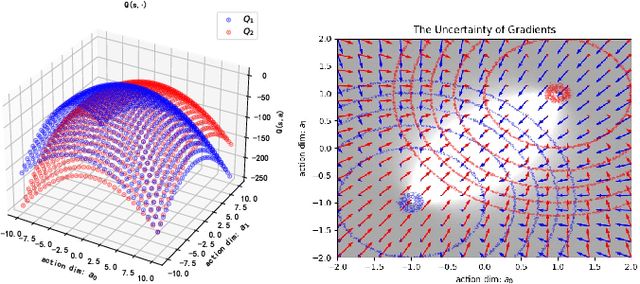

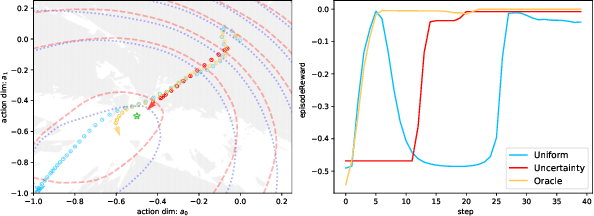
Abstract:Reinforcement Learning (RL) is a widely employed technique in decision-making problems, encompassing two fundamental operations -- policy evaluation and policy improvement. Enhancing learning efficiency remains a key challenge in RL, with many efforts focused on using ensemble critics to boost policy evaluation efficiency. However, when using multiple critics, the actor in the policy improvement process can obtain different gradients. Previous studies have combined these gradients without considering their disagreements. Therefore, optimizing the policy improvement process is crucial to enhance learning efficiency. This study focuses on investigating the impact of gradient disagreements caused by ensemble critics on policy improvement. We introduce the concept of uncertainty of gradient directions as a means to measure the disagreement among gradients utilized in the policy improvement process. Through measuring the disagreement among gradients, we find that transitions with lower uncertainty of gradient directions are more reliable in the policy improvement process. Building on this analysis, we propose a method called von Mises-Fisher Experience Resampling (vMFER), which optimizes the policy improvement process by resampling transitions and assigning higher confidence to transitions with lower uncertainty of gradient directions. Our experiments demonstrate that vMFER significantly outperforms the benchmark and is particularly well-suited for ensemble structures in RL.
Let Storytelling Tell Vivid Stories: An Expressive and Fluent Multimodal Storyteller
Mar 12, 2024Abstract:Storytelling aims to generate reasonable and vivid narratives based on an ordered image stream. The fidelity to the image story theme and the divergence of story plots attract readers to keep reading. Previous works iteratively improved the alignment of multiple modalities but ultimately resulted in the generation of simplistic storylines for image streams. In this work, we propose a new pipeline, termed LLaMS, to generate multimodal human-level stories that are embodied in expressiveness and consistency. Specifically, by fully exploiting the commonsense knowledge within the LLM, we first employ a sequence data auto-enhancement strategy to enhance factual content expression and leverage a textual reasoning architecture for expressive story generation and prediction. Secondly, we propose SQ-Adatpter module for story illustration generation which can maintain sequence consistency. Numerical results are conducted through human evaluation to verify the superiority of proposed LLaMS. Evaluations show that LLaMS achieves state-of-the-art storytelling performance and 86% correlation and 100% consistency win rate as compared with previous SOTA methods. Furthermore, ablation experiments are conducted to verify the effectiveness of proposed sequence data enhancement and SQ-Adapter.
A Dataset for the Validation of Truth Inference Algorithms Suitable for Online Deployment
Mar 10, 2024



Abstract:For the purpose of efficient and cost-effective large-scale data labeling, crowdsourcing is increasingly being utilized. To guarantee the quality of data labeling, multiple annotations need to be collected for each data sample, and truth inference algorithms have been developed to accurately infer the true labels. Despite previous studies having released public datasets to evaluate the efficacy of truth inference algorithms, these have typically focused on a single type of crowdsourcing task and neglected the temporal information associated with workers' annotation activities. These limitations significantly restrict the practical applicability of these algorithms, particularly in the context of long-term and online truth inference. In this paper, we introduce a substantial crowdsourcing annotation dataset collected from a real-world crowdsourcing platform. This dataset comprises approximately two thousand workers, one million tasks, and six million annotations. The data was gathered over a period of approximately six months from various types of tasks, and the timestamps of each annotation were preserved. We analyze the characteristics of the dataset from multiple perspectives and evaluate the effectiveness of several representative truth inference algorithms on this dataset. We anticipate that this dataset will stimulate future research on tracking workers' abilities over time in relation to different types of tasks, as well as enhancing online truth inference.
Crafting a Good Prompt or Providing Exemplary Dialogues? A Study of In-Context Learning for Persona-based Dialogue Generation
Feb 17, 2024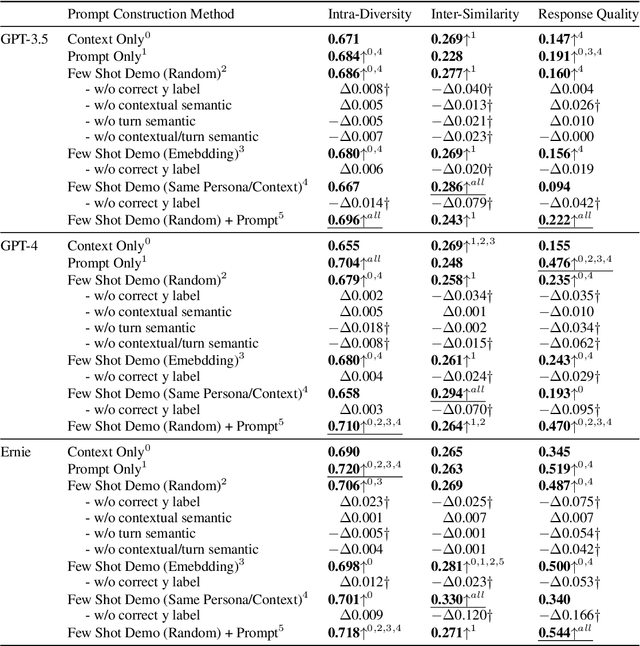
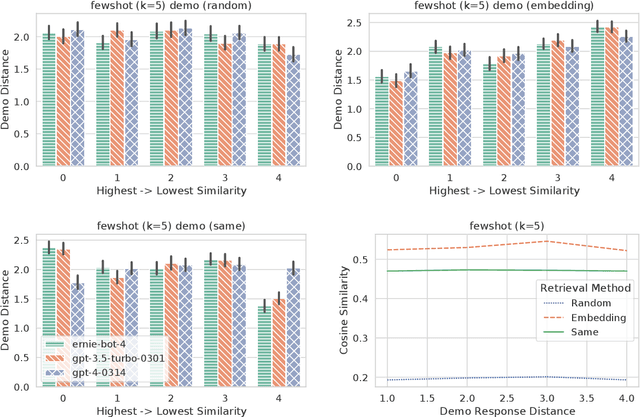
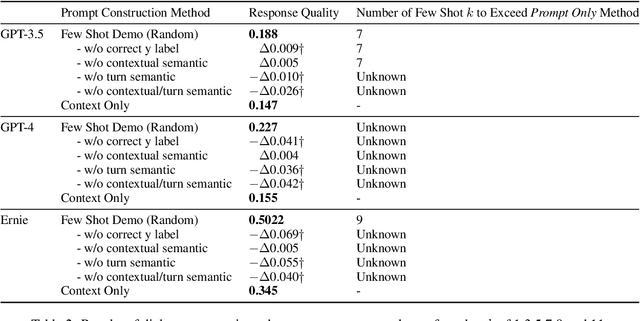
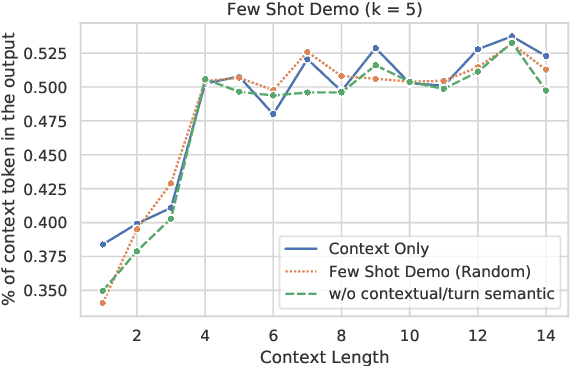
Abstract:Previous in-context learning (ICL) research has focused on tasks such as classification, machine translation, text2table, etc., while studies on whether ICL can improve human-like dialogue generation are scarce. Our work fills this gap by systematically investigating the ICL capabilities of large language models (LLMs) in persona-based dialogue generation, conducting extensive experiments on high-quality real human Chinese dialogue datasets. From experimental results, we draw three conclusions: 1) adjusting prompt instructions is the most direct, effective, and economical way to improve generation quality; 2) randomly retrieving demonstrations (demos) achieves the best results, possibly due to the greater diversity and the amount of effective information; counter-intuitively, retrieving demos with a context identical to the query performs the worst; 3) even when we destroy the multi-turn associations and single-turn semantics in the demos, increasing the number of demos still improves dialogue performance, proving that LLMs can learn from corrupted dialogue demos. Previous explanations of the ICL mechanism, such as $n$-gram induction head, cannot fully account for this phenomenon.
 Add to Chrome
Add to Chrome Add to Firefox
Add to Firefox Add to Edge
Add to Edge